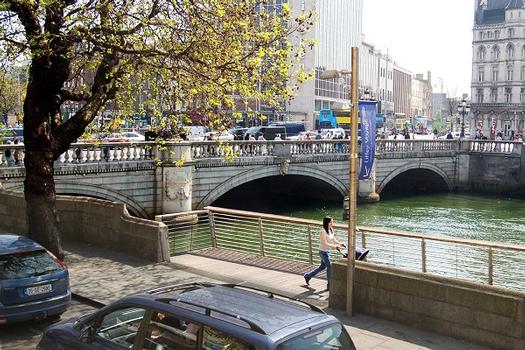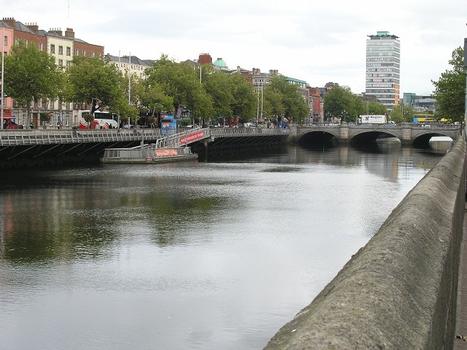General Information
Project Type
| Structure: |
Segmental arch bridge |
|---|---|
| Function / usage: |
Road bridge |
Location
Technical Information
There currently is no technical data available.
Chronology
| 1880 | Widened. |
|---|
Excerpt from Wikipedia
O'Connell Bridge (Irish:Droichead Uí Chonaill) is a road bridge spanning the River Liffey in Dublin, and joining O'Connell Street to D'Olier Street, Westmoreland Street and the south quays.
History
The original bridge (named Carlisle Bridge for the then Lord Lieutenant of Ireland – Frederick Howard, 5th Earl of Carlisle) was designed by James Gandon, and built between 1791 and 1794.
Originally humped, and narrower, Carlisle bridge was a symmetrical, three semicircular arch structure constructed in granite with a Portland stone balustrade and obelisks on each of the four corners. A keystone head at the apex of the central span symbolises the River Liffey, corresponding to the heads on the Custom House (also designed by James Gandon) which personify the other great rivers of Ireland.
Since 1860, (following similar work on Essex Bridge – now Grattan Bridge), to improve the streetscape and relieve traffic congestion on the bridge, it was intended to widen Carlisle Bridge to bring it to the same width as 70 metres (230 ft) wide Sackville Street (now O'Connell Street) which formed the north side carriageway connection to the Bridge. Between 1877 and 1880 the bridge was reconstructed and widened. As can be seen on orthophotography it spans now 45 m of the Liffey and is about 50 m wide.
When the bridge was reopened c.1882 it was renamed for Daniel O'Connell when the statue in his honour was unveiled.
In recent years, the lamps that graced the central island have been restored to their five lantern glory. In 2004, a pair of pranksters installed a plaque on the bridge dedicated to Father Pat Noise, which remained unnoticed until May 2006, and is still there as of April 2019.
Arthur Fields, locally known as The Man on The Bridge, took more than 182,000 photographs of pedestrians on the bridge from the 1930s to the 1980s.
Text imported from Wikipedia article "O''Connell Bridge" and modified on July 23, 2019 according to the CC-BY-SA 4.0 International license.
Participants
- James Gandon (designer)
Relevant Web Sites
- About this
data sheet - Structure-ID
20005736 - Published on:
01/10/2002 - Last updated on:
28/05/2021






